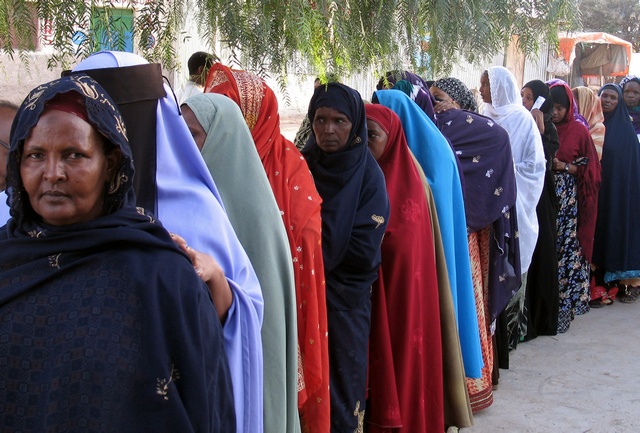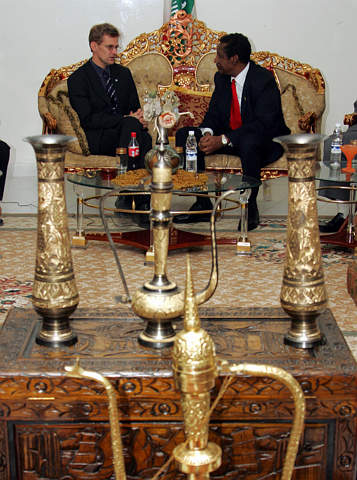| Zooming in Somaliland |
|
A DEMONSTRATOR OUTSIDE PARLIAMENT IN LONDON DEMANDS SELF-DECLARED REPUBLIC OF SOMALILAND TO BE RECOGNISED - March 17, 2004
SOMALILAND SEEKS RECOGNITION
President Dahir Rayaale
SOMALILAND TO SEEK RECOGNITION AS INDEPENDENT
NICK CHARLES 31 December 1992 The Plain Dealer Cleveland, OH
"We're going to hustle everybody and grab them by the collar and lobby for recognition,"
Hassan Essa Jama
The vice president of Somaliland said his country would attend the Somali faction conference in Addis Ababa, Ethiopia, on Monday.
"As a matter of policy at Cabinet level, we have reversed policy of boycotting all types of Somali reconciliation," said Hassan Essa Jama on Monday, at the ramshackle presidential residence.
A senior United Nations official in Hargeisa confirmed that Somaliland, a region in the northern part of Somalia, had accepted an offer to attend the conference as an observer, but not to participate.
"We're prepared to attend as observers," said Essa Jama. "Even if no one recognizes us, we recognize ourself."
Somaliland declared itself independent in May 1991, and reverted to its colonial borders under British rule.
Though the country has yet to be officially recognized by any nation, its government, made up of members of the Somali National Movement, has been invited to other Somali peace talks.
It had refused to attend until now.
"We're going to hustle everybody and grab them by the collar and lobby for recognition," said Essa Jama. "The time has come to show some flexibility."
But while Essa Jama has said government representatives are going, he acknowledged that clan elders were not told until yesterday and that a public meeting would not be held on the move until later.
While the government has met little opposition and has few public critics, there are those who think it is in desperate straits.
We're in a political and constitutional crisis," said Suleiman Gaal, the former minister of the interior. "We've got ministers but not ministries," except for the Ministry of Health, which gets support from Save the Children Fund, Doctors Without Borders, and UNICEF.
Gaal, 58, complained that the Somali National Movement hadn't lived up to its constitution, and had changed the government without a meeting of its Central Committee.
"I used to hate the American motto, that the least government is the best," added Gaal. "But no more."
The meeting on Monday, to be presided over by United Nations Secretary-General Boutros Boutros-Ghali, is an attempt to get all the warring factions in Somalia together.
Boutros-Ghali is on record as not favoring recognition of Somaliland, and while an Egyptian official, he was a friend of former Somali strongman Gen. Mohammed Siad Barre.
"We view his (Boutros-Ghali's) stand on Somaliland as regrettable," said Essa Jama.
As for the secretary-general's friendship with Barre, Jama added: "The world is full of ex-friends of Siad Barre."
Plain dealer Reporter Nick Charles is on special assignment in Somalia and East Africa
© The Plain Dealer 1992
Exploration Background
The leadership in Hargeisa says the boundaries of the new republic are the same as those of "British Somaliland"
May 31, 1993
Somaliland and Somalia have an area of 637,657 sq km, bordered by Djibouti and Ethiopia to the north and north-west and Kenya to the south-west. The region has an extensive coastline on the Gulf of Aden in the north (Somaliland) and the Indian Ocean on the east side and south-east, totalling about 3,000 km.
Like their neighbours, Somaliland and Somalia have major mineral resources. Somaliland in the north has various deposits including industrial salt, zinc, iron, coal, granite and uranium. Some of the world's largest gypsum reserves are found near Berbera. There are also large deposits of pure limestone, which have provided feedstock for cement production near Berbera. But oil exploration so far has yielded no conclusive results.
There are no clear, mutually agreed boundaries between the self-proclaimed republic of Somaliland in the north and Somalia in the south. Somaliland, under the control of the Somali National Movement (SNM), declared its independence from the rest of the country in May 1991, months after Somalia's dictator Mohammed Siad Barre was toppled.
The capital of Somaliland now is Hargeisa, 800 km north-west of Somalia's capital Mogadishu. Somalia's various armed factions have condemned the secession and no country has recognised Somaliland. On May 9, Mohammed Ibrahim Egal was elected "president" of Somaliland by 150 elders representing various ethnic groups. He replaced Abdulrahman Ahmad Ali, who was criticised for failing to achieve recognition for Somaliland.
Over the past 10 years most oil companies' interest has focused on this northern Somali region. But no one among Somalia's planners in the early 1980s had thought that the country would be divided. E&P blocks had been mapped according to geological, rather than political, parameters. Now some of these blocks overlap between Somaliland and Somalia (as the map shows).
The leadership in Hargeisa says the boundaries of the new republic are the same as those of "British Somaliland". (Unlike the rest of Somalia which was an Italian colony, Somaliland was a British protectorate from 1884/86 until June 26, 1960, when it got independence. Somalia declared independence from Italy on July 1, and the two parts united under a treaty. On May 17, 1991 a "Burao Declaration" issued by the SNM declared the treaty to be legally invalid "because nobody first consulted the people". It said that since 1960 the northerners had been held "hostage" to the Somali constitution - see News Service of this week's APS Diplomat Package).
New Downstream Centre In Berbera?
If the republic of Somaliland survives and if the oil companies return to the region and find large hydrocarbon reserves, the port city of Berbera could become an oil export centre. It is a big "If", for both the oil companies and the Hargeisa government.
Assuming that things will develop the way Hargeisa planners have hoped in the past two years, Berbera could also become a free zone like Aden. The zone could be the site of an oil terminal and storage facilities, an oil refinery, etc. If natural gas is found in commercial quantities, there could also be gas-fired power plants and a chemical industry.
This is what officials in Hargeisa are dreaming about. They reject the notion of Somaliland reuniting with Somalia. They have dismissed the newly proposed Somali National Petroleum Corporation (SNPC), a concern to be set up by former prime minister of Somalia Omar Arteh Ghalib who is now based in Saudi Arabia, saying this will never be allowed to operate in Somaliland (see following pages).
Some of the blocks located within Somaliland are of particular interest and are said to be rich in oil. The most interesting areas in this region are tracts on the Gulf of Aden held by Chevron, Amoco, Conoco and Agip.
Bordering most of these from the Ethiopian side lies a very large block held by Maxus, which is believed to be gas-prone related to a gas field in the Ogaden desert (see Ethiopia section).
Chevron has the north-westernmost tracts, including onshore Block 30 on the border with Djibouti and (at the tip by the coastal town of Zeila) close to the Gulf of Tadjoura, and the M-11 offshore area. Its Block 32 is part-onshore and part-offshore.
Chevron is said to have found some oil in one of these areas before civil war broke out in 1988. Chevron had interesting blocks in Sudan as well which, as in the case of its northern Somali exploration, it had to vacate because of civil war (see Part 2).
Amoco has the equally prospective Block 35, just east of Berbera, which is partly offshore and bordering with Block 32, in partnership with International Petroleum Corporation (IPC) of Canada. This and Chevron's blocks used to be part of a huge concession, known as Duban, first acquired in 1980 jointly by Hunt Oil Co. of Dallas and Quintana Oil Co. of Houston.
After two years of unsuccessful work and efforts to find other companies to fund their exploration programme, Hunt concentrated on Yemen where it found a major oilfield. Eventually the partnership broke down and that concession was relinquished.
© 1993 Arab Press Service Organisation
Somaliland Flag
Hargeysa
A Somali trader Shukri Ismail, 46 (R) sells her wares at a big trade fair in the centre of Hargeisa, the capital of Somaliland
Women line up to vote in Hargeisa during first multiparty parliamentary elections in breakaway Somaliland
U.N. emergency relief coordinator Egeland meets Somaliland President Dahir Ryale Kahin in Hargeisa.
|
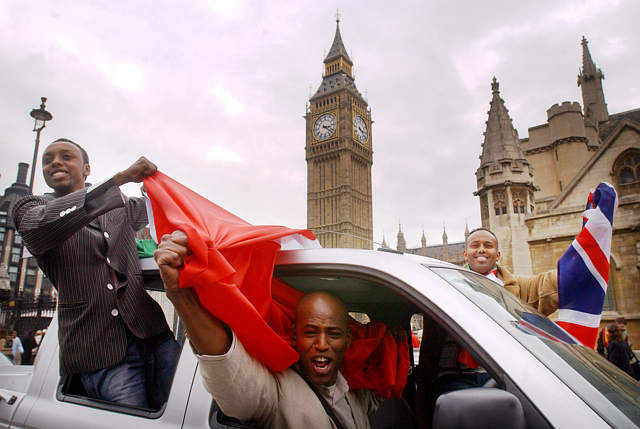
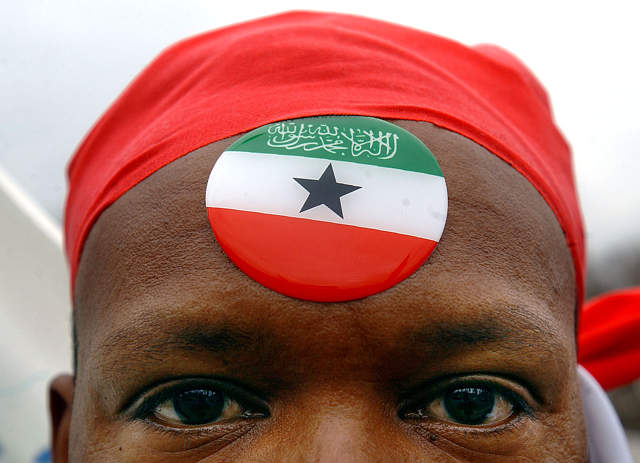
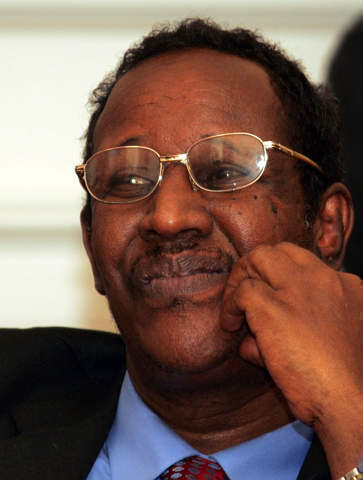
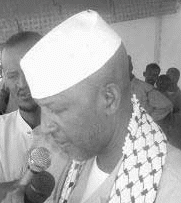
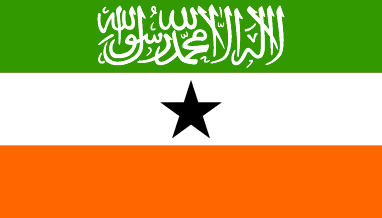
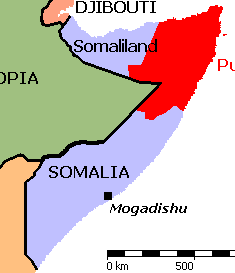

.jpg)
